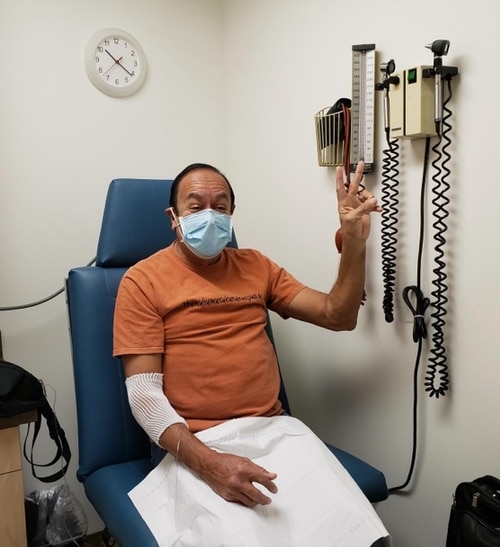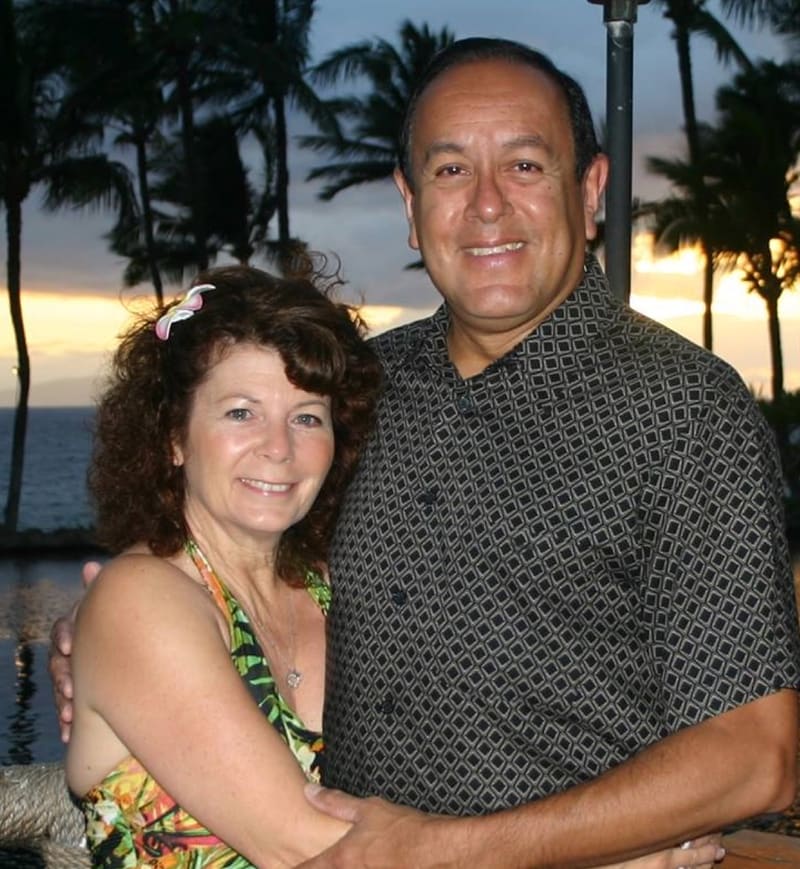
Biosimilars and Me
PETE MENDEZ
LIVING WITH: Ulcerative Colitis LIVES IN: Santa Clarita, CA
DIAGNOSED: 2015 TAKING A BIOSIMILAR SINCE: 2018
Ulcerative Colitis derailed an active life
At 61, Pete Mendez is more active than many people have ever been. He is a volleyball enthusiast and player who spent many weekends setting and lobbing balls or diving across gym floors. Before the pandemic, you could find him and his wife, Sophia, dancing the nights away or making frequent getaways to Hawaii and Cabo San Lucas.
But about five years ago, Mendez’ newly diagnosed ulcerative colitis threatened to ruin all of that.“We loved to travel,” Pete says. “But if my wife planned something, I had to jump on Google Maps and find where all the restrooms were just in case, because you never know. When I had the urge to go, I had literally maybe minutes to get to somewhere. One of my biggest fears was flying on a plane and needing to go, but there was a line for the bathroom.”
After being diagnosed, the medications he was prescribed caused other problems. His first medication, a steroid, ratcheted up his appetite and lead to weight gain. The medication also sapped his energy. Even taking a short walk would be draining and leave him breathless. Worst of all, it did not relieve his symptoms. Mendez was prescribed other medications with fewer side effects, but they also failed to relieve the ulcerative colitis symptoms. “I finally told my doctor, nothing’s working,” Pete says. “There must be something else.”

“My symptoms were so unmanageable I couldn’t sleep. My life revolved around bathrooms. It was no way to live.”
Starting on a biosimilar
Mendez’ gastroenterologist recommended he take a biosimilar, a type of medicine based on a compound known as a biologic. Biologics are large, complex compounds derived from living organisms and made by complicated manufacturing processes.
A biosimilar is highly similar to, but not an exact copy of, an existing biologic. Even so, you can’t call a biosimilar a “generic” biologic. While biosimilars are not generics, they are a version of the biologic, they cost less than a biologic and they become available after the original drug loses its exclusive patent.
For people with IBD, a biologic is often prescribed when other medications have failed to manage their symptoms or make their disease go into remission. Today, some patients may be prescribed a biosimilar instead.

None of that concerned Mendez, however. He was not thrilled about the need to spend hours receiving the medication as an infusion. “I kept postponing taking the biosimilar because I was fearful. The medicine wasn’t a pill or a shot. I’d have to get it through an IV. It would take hours and I’d have to do it every six to eight weeks. Nobody wants to commit themselves to having to do that.”
Meanwhile his ulcerative colitis worsened. At one point, he didn’t bother to leave his home; the urgency was too frequent and there was no guarantee a bathroom would be near enough. “I couldn’t sleep. I was up all hours. I had to do something.”
An active life regained
Mendez agreed to begin the biosimilar infusions. His first one took about four hours. For Mendez, the effects were dramatic. “Three days later, my symptoms suddenly disappeared. It was wonderful.”
Mendez talks about his experience to reassure other people living with IBD who are seeking therapy that will help them. “The first thing I would tell people who may need to take a biosimilar or biologic is that they have nothing to be afraid of. The medications are here to help us. Don’t wait to feel better.”
Mendez enjoys long walks with his wife again and is looking forward to the next time he can ride a plane.
“The medication is a godsend. It put my life back together and took away the worry and fear.”

Questions with Pete
Question: Did you know what a biosimilar was before you began to take one?
Mendez: No. I did not know what a biologic was either. The way I understood it for myself was that the biologic was the “name brand” drug and the biosimilar was the “off brand.”
Question: What were your concerns about starting a biosimilar?
Mendez: I was not concerned about the biosimilar itself. My concern was committing to an IV infusion every six to eight weeks. It seemed like a serious commitment then, but it turned out to be the best decision for me.
Question: You started taking a biosimilar for ulcerative colitis back in 2015. About a year ago, you changed health plans and the new plan required that you switch from the biosimilar to a biologic. Did you notice any difference in the administration or side effects since switching from the biosimilar?
Mendez: No. I was concerned about the transition, at first, wondering if it was ok to go from one to another. My doctor explained that it was ok and safe. When I switched, I didn’t notice a difference. I haven’t had any side effects. The transition was really smooth.
“My life is back.”

This program was developed by Knighten Health on behalf of the AGA Institute and supported by independent medical education grants from Amgen Inc., Pfizer Inc., and Boehringer Ingelheim. The supporting organizations had no involvement in the development of this video or of the associated website and its content.
The views and statements expressed here are those of the video subjects and do not necessarily reflect the positions or beliefs of the American Gastroenterological Association or its members, the AGA Institute or any other subsidiary, agency, sponsor or funder.